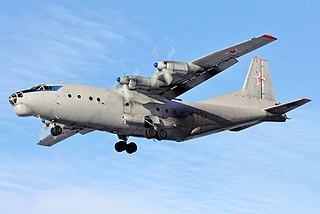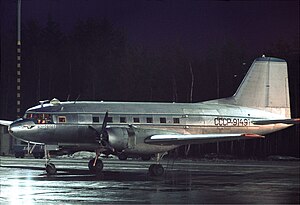
The Ilyushin Il-10 is a Soviet ground attack aircraft developed at the end of World War II by the Ilyushin construction bureau. It was also license-built in Czechoslovakia by Avia as the Avia B-33.

The Ilyushin Il-62 is a Soviet long-range narrow-body jetliner conceived in 1960 by Ilyushin. As successor to the popular turboprop Il-18 and with capacity for almost 200 passengers and crew, the Il-62 was the world's largest jet airliner when first flown in 1963. The seventh quad engined, long-range jet airliner to fly, it was the first such type to be operated by the Soviet Union and a number of allied nations.

The Ilyushin Il-18 is a large turboprop airliner that first flew in 1957 and became one of the best known Soviet aircraft of its era. The Il-18 was one of the world's principal airliners for several decades and was widely exported. Due to the aircraft's durability, many examples achieved over 45,000 flight hours and the type remains operational in both military and civilian capacities. The Il-18's successor was the longer-range Ilyushin Il-62.

The Yakovlev Yak-40 is a regional jet designed by Yakovlev. The trijet's maiden flight was in 1966, and it was in production from 1967 to 1981. Introduced in September 1968, the Yak-40 has been exported since 1970.

The Tupolev Tu-154 is a three-engined, medium-range, narrow-body airliner designed in the mid-1960s and manufactured by Tupolev. A workhorse of Soviet and (subsequently) Russian airlines for several decades, it carried half of all passengers flown by Aeroflot and its subsidiaries, remaining the standard domestic-route airliner of Russia and former Soviet states until the mid-2000s. It was exported to 17 non-Russian airlines and used as a head-of-state transport by the air forces of several countries.

The Ilyushin Il-76 is a multi-purpose, fixed-wing, four-engine turbofan strategic airlifter designed by the Soviet Union's Ilyushin design bureau as a commercial freighter in 1967, to replace the Antonov An-12. It was developed to deliver heavy machinery to remote, poorly served areas. Military versions of the Il-76 have been widely used in Europe, Asia and Africa, including use as an aerial refueling tanker or command center.

Czech Airlines is the flag carrier of Czech Republic. Its head office is located in the Vokovice area of Prague's 6th district and its hub is Václav Havel Airport Prague.
MALÉV Ltd., which did business as MALÉV Hungarian Airlines, was the flag carrier of Hungary from 1946 until 2012. Its head office was in Budapest, with its main hub at Budapest Ferenc Liszt International Airport. The airline flew to over 50 cities in 34 countries with a fleet of 22 aircraft. Malév joined the Oneworld alliance on 29 March 2007. On 3 February 2012, Malév ceased operations and on 14 February 2012 was declared insolvent by the Metropolitan Court of Budapest.

The Ilyushin Il-28 is a jet bomber of the immediate postwar period that was originally manufactured for the Soviet Air Forces. It was the Soviet Union's first such aircraft to enter large-scale production. It was also licence-built in China as the Harbin H-5. Total production in the USSR was 6,316 aircraft, and over 319 H-5s were built. Only 187 examples of the HJ-5 training variant were manufactured. In the 1990s hundreds remained in service with various air forces over 50 years after the Il-28 first appeared. The only H-5s in service currently are approximately 80 aircraft which operate with the Korean People's Air Force. The Il-28 has the USAF/DoD reporting name "Type 27" and ASCC reporting name "Beagle", while the Il-28U trainer variant has the USAF/DoD reporting name "Type 30" and NATO reporting name Mascot.

The Antonov An-24 is a 44-seat twin turboprop transport/passenger aircraft designed in 1957 in the Soviet Union by the Antonov Design Bureau and manufactured by Kyiv, Irkutsk and Ulan-Ude Aviation Factories.

Vnukovo, formally Vnukovo Andrei Tupolev International Airport, is a dual-runway international airport located in Vnukovo District, 28 km (17 mi) southwest of the centre of Moscow, Russia. It is one of the four major airports that serve Moscow, along with Domodedovo, Sheremetyevo, and Zhukovsky.

The Antonov An-12 is a four-engined turboprop transport aircraft designed in the Soviet Union. It is the military version of the Antonov An-10 and has many variants. For more than three decades the An-12 was the standard medium-range cargo and paratroop transport aircraft of the Soviet air forces. A total of 1,248 were eventually built.

The Tupolev Tu-14, was a Soviet twinjet light bomber derived from the Tupolev '73', the failed competitor to the Ilyushin Il-28 'Beagle'. It was used as a torpedo bomber by the mine-torpedo regiments of Soviet Naval Aviation between 1952–1959 and exported to the People's Republic of China.

The Lisunov Li-2, originally designated PS-84, was a license-built Soviet-version of the Douglas DC-3. It was produced by Factory #84 in Moscow-Khimki and, after evacuation in 1941, at TAPO in Tashkent. The project was directed by aeronautical engineer Boris Pavlovich Lisunov.

The Yemeni Air Force is the air operations branch of the Yemeni Armed Forces. Numbers of aircraft can not be confirmed but serviceability of these aircraft is low. Aircraft have been acquired by donations from other countries supporting either the Soviet Union or the United States during the Cold War. However, most of the air force was destroyed by airstrikes during the Saudi Arabian-led intervention in Yemen.

Kbely Aviation Museum is the largest aviation museum in the Czech Republic and one of the largest of its kind in Europe. It is located to the north-east of Prague, at the military airport Kbely.

Aeropark is an open-air aviation museum next to Ferenc Liszt International Airport, Budapest, Hungary. It is dedicated to the history of Hungarian civil aviation, featuring several types used by the now-defunct national airline Malév.

Aeroflot Flight B-2 was a regularly scheduled passenger flight operated by Aeroflot from Vitim Airport in the Sakha Republic to Irkutsk International Airport near Irkutsk. On 20 July 1977, the Avia 14 operating this flight crashed into trees outside the airport shortly after takeoff. Thirty-three passengers and all six crewmembers were killed, while one passenger survived.



























